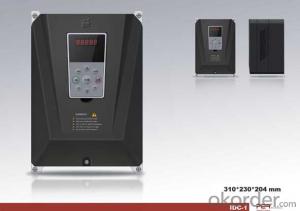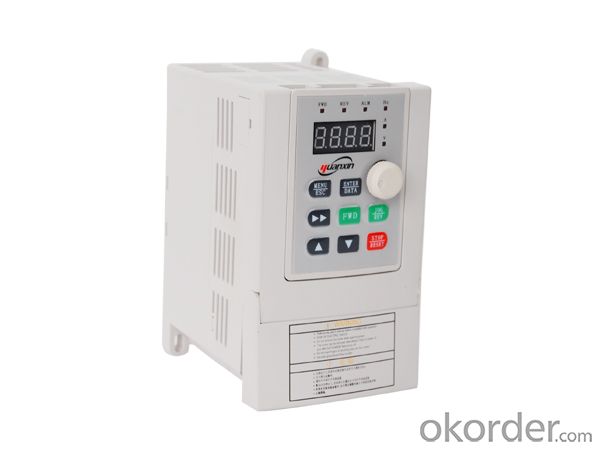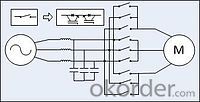LI XIANG Variable-frequency drive-lx3000_02
- Loading Port:
- Ningbo
- Payment Terms:
- TT OR LC
- Min Order Qty:
- 1 unit
- Supply Capability:
- 10 unit/month
OKorder Service Pledge
OKorder Financial Service
You Might Also Like
Generic topologies
Topology of VSI drive
Topology of CSI drive
Six-step drive waveforms
Topology of direct matrix converter
AC drives can be classified according to the following generic topologies:
Voltage-source inverter (VSI) drive topologies (see image): In a VSI drive, the DC output of the diode-bridge converter stores energy in the capacitor bus to supply stiff voltage input to the inverter. The vast majority of drives are VSI type with PWM voltage output.
Current-source inverter (CSI) drive topologies (see image): In a CSI drive, the DC output of the SCR-bridge converter stores energy in series-reactor connection to supply stiff current input to the inverter. CSI drives can be operated with either PWM or six-step waveform output.
Six-step inverter drive topologies (see image): Now largely obsolete, six-step drives can be either VSI or CSI type and are also referred to as variable-voltage inverter drives, pulse-amplitude modulation (PAM) drives, square-wave drives or D.C. chopper inverter drives. In a six-step drive, the DC output of the SCR-bridge converter is smoothed via capacitor bus and series-reactor connection to supply via Darlington Pair or IGBT inverter quasi-sinusoidal, six-step voltage or current input to an induction motor.
Load commutated inverter (LCI) drive topologies: In an LCI drive (a special CSI case), the DC output of the SCR-bridge converter stores energy via DC link inductor circuit to supply stiff quasi-sinusoidal six-step current output of a second SCR-bridge's inverter and an over-excited synchronous machine.
Cycloconverter or matrix converter (MC) topologies (see image): Cycloconverters and MCs are AC-AC converters that have no intermediate DC link for energy storage. A cycloconverter operates as a three-phase current source via three anti-parallel-connected SCR-bridges in six-pulse configuration, each cycloconverter phase acting selectively to convert fixed line frequency AC voltage to an alternating voltage at a variable load frequency. MC drives are IGBT-based.
Doubly fed slip recovery system topologies: A doubly fed slip recovery system feeds rectified slip power to a smoothing reactor to supply power to the AC supply network via an inverter, the speed of the motor being controlled by adjusting the DC current.
Control platforms
See also: Dqo transformation and Alpha–beta transformation
Most drives use one or more of the following control platforms:
PWM V/Hz scalar control
PWM field-oriented control (FOC) or vector control
Direct torque control (DTC).
Load torque and power characteristics
Variable-frequency drives are also categorized by the following load torque and power characteristics:
Variable torque, such as in centrifugal fan, pump, and blower applications
Constant torque, such as in conveyor and positive-displacement pump applications
Constant power, such as in machine tool and traction applications.
- Q: hi, i am in my final year electrical engineering can any one provide me the latest booming seminar topics.
- see this website engineering.electrical-equipment.
- Q: and can they be prosecuted? (UK)
- Most electrical or electronic equipment is governed by a user honesty system where if the interfere with other equipment they are required to fix it. Especially if it is ham radio or CB radio. If it is a sewing machine or other home electrical item ring your communications dept. and they will take care of it. Sewing machines can be quite noisy as far as signals and interference go. As far as prosecution is concerned, that won't be up to you. The relevant dept will make that call based on what sort of equipment they are using. I think you should find out which dept. is in charge of radio signals and the like and talk to them. Good luck VK3FMPB
- Q: I know you need fuses for cars, electrical equipments, etc. I don't get what they are really used for?
- Fuses and circuit breakers are used to prevent damage to an electrical circuit due to a short or overload. All circuits have at least a positive side and a ground (negative) side. If the positive and ground sides of the circuit touch each other the result is intense heat generated by the electrical current. The job of the fuse or circuit breaker is to stop the flow of electricity when an overload occurs in the circuit so excessive damage to the components of the circuit does not take place (wiring,computers,relays,etc.). All circuits are designed to carry a certain load (amps), DO NOT EVER replace a fuse with one of a higher rating(example: do not replace a 10amp fuse with a 15 or 20amp one) if the normal fuse blows there is a problem that needs to be located and repaired! I have seen MANY vehicles severly damaged because an owner or backyard mechanic replaced a blown fuse with one that was not the same rating as the one removed. I have seen burnt up vehicles from this action. If the fuse blows there is a problem, putting a higher rated fuse in WILL NOT fix the problem, it will more than likely cause major damage to the circuit or possibly cause a fire that will destroy the vehicle. (retired mechanic, from an electrical repair garage)
- Q: I quest it will be a big surprise to everybody. a) He will make a big party on earth. b) It will be a new beginning. c) It is the end of the happy moment on earth.
- He will bring the judgment.
- Q: I'm about to take an automotive electronics class at college but I'm just curious, what are the basics? Say I want to wire a police scanner or some type of lightbar into my car's electrical system. What would this entail? I'd have to pull away body panels, run wire, and hook it into the battery? What about fuses, safeties, etc And also how could I hook my police scanner into my speaker's system?
- Fuse blocks in cars often have SPARE (usually disused in some particular model) positions with wires already attached and within the wiring loom, with nothing connected to the end. Knowing what the intended accessory was, might allow you to connect something to its unconnected end, and always, the negative return is the car's frame. The circuit must be capable of carrying the current required. Some of these spares may be connected via the ignition switch, some may not. The next alternative is to run a new wire with a fuse inline, at the supply end at least. It is good practice to fuse the supply end, then have a further fuse at the accessory end (most accessories will already have this). The wire can often be run along and fixed to the existing car looms, passing through the firewall where the loom passes through. Again, negative is anywhere convenient on the car's metal frame. A quick and simple connection is the cigarette lighter, if fitted. Just procure a plug to replace the lighter. It can supply a fair current. So far as connecting a scanner to the existing speakers, I suggest you don't try to, unless the audio/ radio system has an accessory input. Maybe a bluetooth connection might be used, but really, the scanner's own speaker should supply the scanner sound. You can also connect accessories by splicing into existing car circuits, but I would suggest you do your college course first! You really need to understand current and wire sizes and fusing (not to mention basic circuitry!), before splicing into existing wires.
- Q: I work on a plant where my workers have to trouble shoot low DC control voltage circuits besides high voltages ac running machines which are operated by inverters as well as from direct ac powerNeed a document or some tips to prevent electrical shocks and for electrician guidance
- Work only in dry environments. No water on the floor. Plug AC powered test equipment into a GFCI protected circuit. Really no safety issues on DC voltages under 50V. Only handle electrical leads with one hand. Keep the other in your pocket. Rubber mats to stand on. Rubber gloves worn inside leather gloves Face shield and arc-flash rated clothing when working on anything over 50VAC.
- Q: Every other electrical and electronic equipment in my house is alright. How can alarm company prove the above in a court of law or to Better Business Bureau ?
- The alarm company employs the expert who says so! I'd say it is completely possible. One problem with an alarm system is all the wiring connecting it to the various triggering devices. It is usually long, and elevated, not shielded in any way. It works like a large antenna. So, a lightning flash doesn't even have to cause a surge on the power lines, in order to induce a voltage on all this wire. Distant lightning will produce an EMP (electro-magnetic pulse). It is like a strong radio signal. It only has to exceed the breakdown voltage of any chip it can get to. As this has to be some particular chip, it could be taken out alone. It only takes the destruction of a single gate in it to render it useless. I'm sure the manufacturer would have had enough experience to realise the cause of that particular chip being taken out! Nothing else in your house can present such a large antenna to the pulse.
- Q: Hey im sell a electric fencing sword wet because I just cleaned it with water because im selling it on OKorder.
- Getting any electrical equipment wet with water is a bad idea. The water hastens corrosion, and if it is still wet when it is plugged in, the resulting short-circuit can damage it and other electrical equipment further. If the weapon is an epee or foil, the barrel of the tip will hold the water and rust the spring(s) and contacts. In the future, the best way to clean a weapon is to wipe off any dirt or salt with a clean, damp cloth and dry it immediately. Use a Scotch Brite pad or equivalent to gently remove any rust or scale from the blade, being careful not to damage the wires and insulation in the groove. To keep rust off the blade, wipe the blade with a light coating of machine or gun oil, a paste wax, or silicon car wax. Keep blades away from sweaty jackets, etc. Colored blades, FIE-rated blades, and maraging blades rust less than regular steel because they are either coated with an anodyne (in the case of colored blades) or are made of an alloy that is rust resistant.
- Q: (without using any connection wires)? I frequently need to plug existing electrical equipment in places where there is no power outlet I have to use clumsy long tailed electrical extension plug that hinders free movement ? Short of using a battery in the equipment how to connect the power junction points (earth live neutral to an existing electrical power outlet using nothing but air in between)?
- Air is not a very good conductor. When you generate a spark, you are finally overcoming the insulative value of air and establishing an electrical connection through ionization. Anyone who has seen lightning can appreciate the randomness of the path of this connection. If there are any nearby conductors, the electricity will jump to them. An option for you would be to convert your power into some sort of form that you could beam towards a receiver (laser or microwave comes to mind). A receiver would then take the energy from the signal and convert it back to usable power for your device. A lot of energy will be lost in this process.
Send your message to us
LI XIANG Variable-frequency drive-lx3000_02
- Loading Port:
- Ningbo
- Payment Terms:
- TT OR LC
- Min Order Qty:
- 1 unit
- Supply Capability:
- 10 unit/month
OKorder Service Pledge
OKorder Financial Service
Similar products
Hot products
Hot Searches
































